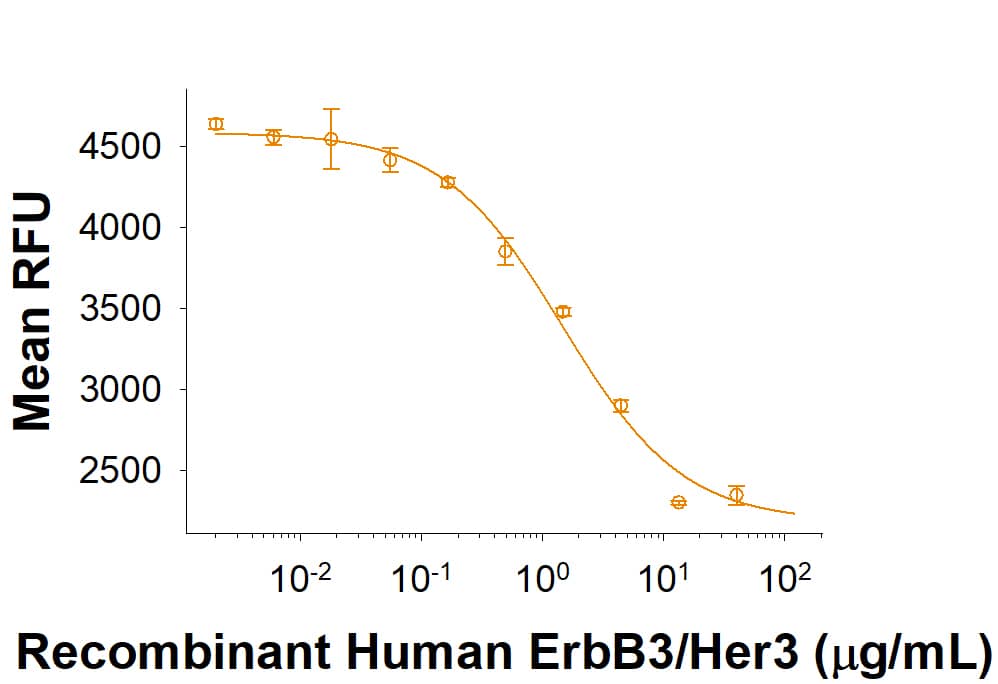Recombinant Human ErbB3/Her3 His-tag Protein, CF
R&D Systems, part of Bio-Techne | Catalog # 10368-RB

Key Product Details
Product Specifications
Source
Human embryonic kidney cell, HEK293-derived human ErbB3/Her3 protein
| Human ErbB3/Her3 (Ser20-Gly538) Accession # P21860-1 |
YSKGSQSRMGGGGALQWNCSGGIQ | 6-His tag |
| N-terminus | C-terminus |
Purity
>95%, by SDS-PAGE visualized with Silver Staining and quantitative densitometry by Coomassie® Blue Staining.
Endotoxin Level
<1.0 EU per 1 μg of the protein by the LAL method.
N-terminal Sequence Analysis
Ser20
Predicted Molecular Mass
61 kDa
SDS-PAGE
73-83 kDa, under reducing conditions
Activity
Measured by its ability to inhibit the biological activity of Neuregulin-1-beta 1 on MCF-7 human breast cancer cells. Karey, K.P. et al. (1988) Cancer Research 48:4083.
The ED50 for this effect is 0.3-3 µg/mL in the presence of 10 ng/mL Recombinant Human NRG1‑ beta1/HRG1‑ beta1 Extracellular Domain (Catalog # 377-HB).
The ED50 for this effect is 0.3-3 µg/mL in the presence of 10 ng/mL Recombinant Human NRG1‑ beta1/HRG1‑ beta1 Extracellular Domain (Catalog # 377-HB).
Scientific Data Images for Recombinant Human ErbB3/Her3 His-tag Protein, CF
Recombinant Human ErbB3/Her3 His-tag Protein Bioactivity
Recombinant Human ErbB3/Her3 His-tag (Catalog # 10368-RB) inhibits the biological activity of Recombinant Human NRG1-beta 1/HRG1-beta 1 ECD Protein (Catalog # 377-HB) on MCF-7 human breast cancer cells. The ED50 for this effect is 0.3-3 µg/mL.Recombinant Human ErbB3/Her3 His-tag Protein SDS-PAGE
2 μg/lane of Recombinant Human ErbB3/Her3 His-tag (Catalog # 10368-RB) was resolved with SDS-PAGE under reducing (R) and non-reducing (NR) conditions and visualized by Coomassie® Blue staining, showing bands at 73-83 kDa.Formulation, Preparation and Storage
10368-RB
| Formulation | Lyophilized from a 0.2 μm filtered solution in PBS. |
| Reconstitution | Reconstitute at 500 μg/mL in PBS. |
| Shipping | The product is shipped at ambient temperature. Upon receipt, store it immediately at the temperature recommended below. |
| Stability & Storage | Use a manual defrost freezer and avoid repeated freeze-thaw cycles.
|
Background: ErbB3/Her3
References
- Kraus, M.H. et al. (1989) Proc. Natl. Acad. Sci. 86:9193.
- Plowman, G.D. et al. (1990) Proc. Natl. Acad. Sci. USA 87:4905.
- Carraway, K.L. 3rd et al. (1994) J. Biol. Chem. 269:14303.
- Emkey, R. and C.R. Kahn (1997) J. Biol. Chem. 272:31172.
- Sundaresan, S. et al. (1998) Endocrinology 139:4756.
- Hellyer, N.J. et al. (1998) Biochem. J. 333:757.
- Schaefer, G. et al. (1999) J. Biol. Chem. 274:859.
- Hellyer, N.J. et al. (2001) J. Biol. Chem. 276:42153.
- Schlessinger, J. (2000) Cell 103:211.
- Daly, R.J. (1999) Growth Factors 16:255.
Long Name
Receptor Tyrosine Protein Kinase ErbB3
Alternate Names
HER3
Gene Symbol
ERBB3
UniProt
Additional ErbB3/Her3 Products
Product Documents for Recombinant Human ErbB3/Her3 His-tag Protein, CF
Product Specific Notices for Recombinant Human ErbB3/Her3 His-tag Protein, CF
For research use only
